Veranstaltungen
Treibgut: Eumig macht das Filmen leicht
Filmprogramm im Rahmen der "Treibgut"-Reihe des Österreichischen Filmmuseums mit Vortrag und Diskussionsbeiträgen von Joachim Schätz.
Wenn "Eumiganer" rückblickend ihre Zeit bei der Firma beschreiben, wird der erfinderische und soziale Charakter des Unternehmens hervorgehoben. Begleitet von einem Filmprogramm diskutieren die Gäste über die Geschichte von Eumig und seine sozialen Aspekte, seine Erfindungen und Experimente sowie seine Rolle für den Lehrfilm in Österreich. – Zu Gast sind Uschi Seemann, Tochter des Geschäftsführers Karl Vockenhuber und Mitbegründerin des eumigMuseums, Gerhard Pahr, ehemaliger Leiter der Eumig Elektronikabteilung, Gus Seemann, Ausstellungs- und Sammlungskurator des eumigMuseums, sowie Joachim Schätz, Universitätsassistent an der Universität Wien.
Ort: Österreichisches Filmmuseum, Augustinerstraße 1, 1010 Wien
Zeit: Sonntag, 23. April 2024, 18:00-20:30
Veranstalter: Österreichisches Filmmuseum
Was wissen Filme, was lehren Filme?
Filmprogramm und Vortrag von Marie-Noëlle Yazdanpanah und Joachim Schätz in der Vermittlungsreihe "Schule im Kino" im Österreichischen Filmmuseum.
Der Film zeigt die Welt nicht nur, wie wir sie kennen. Er gibt uns auch die Möglichkeit, die Dinge anders zu sehen – größer, kleiner, schneller, langsamer ... Oder er präsentiert Gegenden und Vorgänge, die im Alltag nicht zugänglich sind oder nur wenig beachtet werden. Deshalb wurde Film von Anfang an auch als ein neues Mittel gefeiert, um etwas zu lernen. Aber wie funktioniert das, dass aus dem Sehen und Staunen Wissen wird? Gilt das nur für spezielle ‚Lehrfilme‘ und Anleitungsvideos oder auch für 'normale' Filme? Was Filme wissen und wie sie das vermitteln, diskutieren wir anhand von Beispielen aus den letzten 100 Jahren.
Ort: Österreichisches Filmmuseum, Augustinerstraße 1, 1010 Wien
Zeit: Montag, 13. Februar 2023, 10:00 bis 12:00
Veranstalter: Österreichisches Filmmuseum
Bildcredit: Welt des Unsichtbaren (1957, Regie: Ann H. Matzner) (C) Österreichisches Volkshochschularchiv
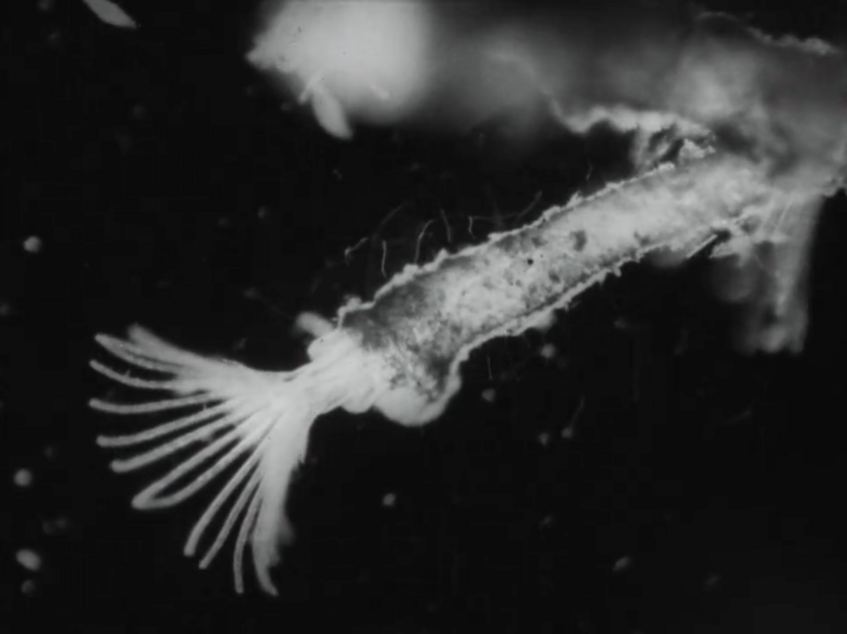
Wir sind hier nicht im Kino! Filmgeschichte als Medienökologie am Beispiel Klassenzimmerprojektion
Vortrag von Joachim Schätz im Rahmen der Ringvorlesung "Fragen stellen, Phänomene eingrenzen, Forschung konzipieren. Methoden der Theater-, Film- und Medienwissenschaft"
Am Beispiel von Filmprojektoren für die Schule und Debatten über ihre Bedienung in den späten 1940er bis 1960er Jahren in Österreich wird das Konzept einer „Ökologie medialer Praktiken“ (Petra Löffler nach Isabelle Stengers) erläutert.
Ort: Hörsaal 5, Universität Wien, UZA II, Josef-Holaubek-Platz 2, 1090 Wien
Zeit: Dienstag 22. November 2022, 11:30-13:00
Veranstalter: tfm | Institut für Theater-, Film- und Medienwissenschaft, Universität Wien
Zwischen Schulung, Werbung und Beratung. Institutionen und Typen des berufsbildenden Lehrfilms in Österreich 1920-1970
Vortrag von Vrääth Öhner und Joachim Schätz bei dem Workshop "Arbeit filmen. Beruf und Arbeit im Gebrauchs-, Spiel- und Dokumentarfilm".
Vrääth Öhner und Joachim Schätz geben anhand von Filmbeispielen einen Einblick in Arten des berufsinformierenden Films in Österreich, von Dachdeckerarbeiten am Stephansdom nach 1945 in Berufsschulfilmen des Unterrichtsministeriums bis zur Bewerbung der Papierfabrikation im ORF um 1970. Im bundesdeutschen Fragezeichenfilm wird auch die Grundsatzfrage verhandelt: Was ist, und wozu, ein Beruf – etwa im Gegensatz zum Job?
Ort: Bankettsaal, mdw – Universität für Musik und darstellende Kunst Wien, Anton-von-Webern-Platz 1, 1030 Wien
Zeit: Freitag, 11. November 2022, 15:00-15:30
Veranstalter: 3s Research and Consulting
Pflegenotstand im Scheinwerferlicht
Ein Filmabend zur Pflegeausbildung. Die Veranstaltung untersucht die Rolle des Films in der Berufsausbildung und als Mittel zur Thematisierung und Bekämpfung des Pflege-(personal-)notstands.
Pfleger*innen stehen nicht erst seit der Corona-Pandemie massiv unter Druck, und kämpfen vielerorts für bessere Arbeitsbedingungen. Österreich steht vor eine Pflege(personal-)notstand. Wie motiviert man in dieser Situation dennoch für einen Pflegeberuf?
Medienkampagnen und Film waren historisch gesehen zentrale Mitteln zur Bekämpfung von Personalengpässen, und sind es heute noch. Film hat jedoch über Werbung für und Gestaltung des Images des Berufs hinaus noch viele weitere Funktionen, etwa als Berufsinformationsfilm oder als Lehr- und Schulungsfilm. Diese "Gebrauchsfilme" stehen häufig in Konflikt mit der Repräsentation des Berufs in Unterhaltungsmedien.
Das Screening bildet den Auftakt zu einem Workshop tags darauf und einer Veranstaltungsreihe zum Thema Beruf, Arbeit und Bildung in Film. Der Schwerpunkt liegt dabei auf dem ephemeren Film (Gebrauchsfilm). Ziel der Auftaktveranstaltung ist die Vernetzung von Filmemacher*innen, Film- und Medienwissenschaft, Berufs- und Arbeitsmarktforschung sowie Bildungsberatung und Arbeitsmarktverwaltung.
Das Screening beginnt mit einer Reihe historischer Lehr- und Berufsinformationsfilme. In Anschluss daran spricht Konrad Wakolbinger mit Axel Stummer, Regisseur, Produzent und Absolvent der Filmakademie, über seinen Film Beruf helfen. Der Hauptfilm Zu jeder Zeit (De chaque instant, FR 2018) von Nicolas Philibert, ein Dokumentarfilm, begleitet auf sehr einfühlsame Weise Pfleger*innen in der Ausbildung und fördert dabei eine gänzlich neue Sicht auf das Geschehen im Krankenhaus und Pflegepersonal zu Tage.
Ort: Arthousekino, mdw – Universität für Musik und darstellende Kunst Wien, Anton-von-Webern-Platz 1, 1030 Wien
Zeit: Donnerstag, 10. November 2022, 18:00-22:00
Veranstalter: 3s Research and Consulting
Zeigen als pädagogische Ur-Geste. Die Praktiken des Lehrfilms
Treibgut-Filmscreening und Diskussion im Österreichischen Filmmuseum von Katrin Pilz und Christian Dewald.
Film in Lehr-, Erziehungs- und volksbildenden Zusammenhängen, funktioniert nicht ohne seine diskursiven Praktiken. Diese seine Identität hat den Lehrfilm, trotz weiter Verbreitung, zu einem ephemeren Medium gemacht, abhängig auch von vermeintlicher Aktualität.
Gegenstand des FWF-Forschungsprojekts "Praktiken des Lehr- und Unterrichtsfilms in Österreich von 1918 bis Ende der 1960er-Jahre", das seit 2019 an der Universität Wien und dem Ludwig Boltzmann Institute for Digital History durchgeführt wird, sind der Lehr- und Unterrichtsfilm als Praktiken. Dieses Verständnis umfasst nicht nur die projizierten Filme, sondern auch die Institutionen, die diese in Auftrag gegeben und vertrieben haben, die Rechtsvorschriften, die zur Regulierung von belehrenden und erziehenden Filmvorführungen erlassen wurden, die Zeigeorte, Didaktiken, Unterrichts- und Vorführpraktiken.
Entlang einer "Alphabetisierung des Lehrfilms", eines Clustering der zahlreichen Formen des Lehrfilms, die drei Grundsäulen – "Unterricht/Ausbildung", "Erziehung/Beratung" und "Volksbildung" – freigelegt hat, werden fünf Programme gezeigt, das Feld des Lehrfilms samt seinen komplexen Rhetoriken, Grammatiken und Strategien kommentiert.
Ort: Österreichisches Filmmuseum, Augustinerstraße 1, 1010 Wien
Zeit: Sonntag, 25. September 2022, 15:00
Bildcredit: The Science and Art of Obstetrics: Laparotrachelotomy: Low Cervical Cesarean Section (1936, Joseph B. DeLee, Quelle: National Library of Medicine, USA)
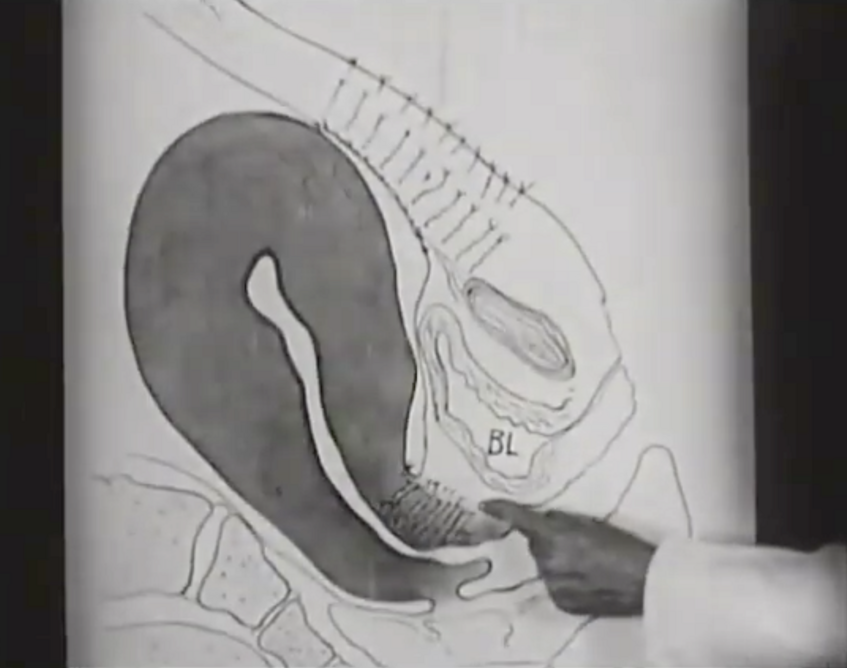
"Archiving Madness". Neurological Film Archives and the Dilemma of Seeing the Invisible Mentally Ill
Vortrag von Katrin Pilz auf der internationalen Tagung "NECS 2022: Epistemic Media: Atlas, Archive, Network".
Medical research and educational films have recently been rediscovered by archives and scholars in various fields. Many of these film collections fell into oblivion after their usefulness expired, were disposed of, or were stored in the vaults of hospitals and research institutes without proper archival care. Separation from the accompanying materials (production notes, research reports, manuals) further complicated evaluation and appreciation of these collections. One of the oldest surviving Belgian films preserved in the Cinématèque Royale de Belgique belong to a collection of clinical short films dating back to 1905 and produced by Arthur Van Gehuchten, a neurologist and professor at the Catholic University of Leuven. Van Gehuchten started to film patients with so called ‘maladies nerveuses’ resulting in movement disorders, such as Parkinson’s and Huntington’s. Since uncontrolled movements were difficult to describe in words, neurologists turned to film for research purposes and medical training. In the following decades, other Belgian neurologists used film as a research tool. Their patients and their illnesses are still documented on film and are often shown today in surprising performative formats.
In this paper, I will examine the role and practice of early Belgian neuroscientific films from 1900 to 1930 from a source-based, multimedia historical perspective. I will discuss the epistemic value of these films, their origins, and challenges of dealing with such medical-film-archives: Where and how have neurological research films resurfaced? What challenges do historians, researchers in various disciplines, and viewers face in screening and viewing these evocative, triggering, disturbing, and difficult-to-classify neurological cases from the past? What should be considered when collecting, preserving, and digitizing this film and content fragile material, (how) should it be made available to audiences for whom it was not originally intended, and how should this unfold for future research and knowledge sharing?
Ort: Politehnica University of Bucharest, Splaiul Independenței 313, București 060042, Rumänien
Zeit: Donnerstag, 23. Juni 2022, 11:00-12:45
Veranstalter: NECS – Network of European Cinema Studies; National University of Theatre and Film, Bucharest
Educational film as practice: epistemic settings and procedures
Panel des Projekts "Praktiken des Lehr- und Unterrichtsfilms in Österreich" auf der internationalen Tagung "NECS 2022: Epistemic Media: Atlas, Archive, Network".
The use of films as means of transmitting knowledge is highly dependent on the institutional, pedagogical and mediated framings that bounded and informed the individual films. Given that, more so than many other types of films, educational films were not supposed to be appreciated as self-contained artifacts, we propose to highlight on educational film as practice. This notion of practice encompasses the pedagogical screening dispositifs within which films were presented as well as the institutional regulations, societal metanarratives and popular tropes that structured epistemic operations done with films. The proposed panel is based in current research on 20th-century useful cinema and the history of education. It encompasses a wide array of educational situations, from classroom films to popular education and films distributed for occupational training and advice: While Joachim Schätz presents set-ups and rhetorics of film-based ‘consultation’ of farmers as a delicate mixture of information and coercion, education and advertising, Kerrin von Engelhardt investigates classroom films’ narratives of science in the context of the German Democratic Republic’s self-image as a science-based state. In her study on alpinism in popular education in 1920s and 1930s Vienna, Marie-Noëlle Yazdanpanah stresses how well-remembered Kulturfilm hits by Arnold Fanck and the likes co-existed with semi-amateur efforts, and films with slides, in the circuit of Uranias and other sites of adult education. In a methodological contribution, Vrääth Öhner proposes terms to glean from pedagogical theory to the investigation of educational films as useful cinema and sketches out their implications. Together, the four presentations tackle a key question of epistemic media(tion): Which procedures and settings does it take for films to make something 'known'?
Respondent: Mireille Berton (Université de Lausanne)
PRESENTATIONS:
Marie-Noëlle Yazdanpanah: Through Ice and Snow. Alpinism in Educational Films
In the 1920s and 1930s, the conquest of the Alps by means of crampons and skis was no longer an elitist practice, but part of a popular leisure activity that was also heavily marketed to tourists. Cinematic and photographic images of the Alps were firmly anchored in the visual memory of the cinema audience and the mountain film, which played an important role in popularising alpinism, had established itself as a successful genre. Around the same time, the Alps gained importance as a topic in popular education. In the presentation, I focus on cinematic representations of alpinism and its multimedia performance practice in the popular education programmes of the Viennese Urania, using the example of the semi-professional amateur film “Mit Steigeisen und Eispickel” (AT c. 1934) and Arnold Fanck's early mountain film and crowd-pleaser “Im Kampf mit dem Berge” (D 1921). I ask how Fanck's film, as part of a media package especially tailored for schoolchildren, was used as an educational film and which media-pedagogical methods and practices were thereby employed: How do entertainment and instruction relate to each other? “Mit Steigeisen und Eispickel” was marketed as a “high-altitude educational film” and functions a visual manual. Considering its semi-amateurism, I investigate how this film relates an established repertoire of images to elements of educational films to introduce the audience to new techniques of ice climbing: What techniques of showing and instructing are discernible and how can they be compared to professional instructional films? And finally: What role do the Alps, which were considered the epitome of “Austria” in both nationalist and tourist contexts, play in an educational film produced during Austrofascism?
Kerrin von Engelhardt (neé Klinger) (Humboldt University Berlin): Narrative Practices in the East German's (GDR) Science Education Film
Narrative practices come into view in the history of science with a praxeological perspective. With reference to Jean-Francois Lyotard, not only rhetorical representational practices in the scientific writing process, but also "fundamental scientific values and ideals of the modern natural sciences, such as the claim to objectivity, the claim to truth or the idea of scientific progress or scientific revolution [...] can be understood as 'metanarratives' of modernity" (Brandt 2009: 85). These metanarratives are not only world explaining, but also legitimizing and pointing the way to the future. The narrative of the 'scientific-technical revolution' functioned as a central metanarrative in the East German self-image. Not least in the education sector, the narrative of the 'scientific-technical revolution' was used to frame reforms in terms of their relevance to society as a whole. ‘Scientificity’ was thus one of the GDR’s education policy slogans, and teaching was supposed to follow scientific principles from the time children entered school.In the GDR, audio visual teaching aids in particular were not only intended to establish proximity to practical applications, but also to convey in an educationally effective way the political required attitudes towards the factual content. This article uses GDR educational films to ask how science was put into picture. Here, educational film is understood as a narrative practice, since “at least one change of state in a given temporal interval”, in which the starting and ending points are “explicitly represented” and conveyed by a narrative instance are revealed (Kuhn 2011: 61; Keutzer et. al 2014: 193).Exemplary educational films for physics, chemistry and biology are examined for their narrative structures. The question is posed as to how the films thereby relate to the metanarrative of the "scientific-technical revolution".
Joachim Schätz: Learning to take advice. Tropes and practices of consultation in the Austrian Ministry of Agriculture‘s educational films work
In comparison to school and university education, the pedagogical procedures and mediated protocols of professional training and advice have been rather understudied both in the history of education and of useful media. This may partly be due to 1) the fuzzy contours of consultation as a pedagogical situation between information, coercion and promotion, and 2) the dependence of individual consulting setups and dynamics on economic, legal and institutional determinants which can hardly be integrated into a uniform concept of consulting. As a case in point, I investigate the film work of the Austrian Ministry of Agriculture during the 1930s and from 1945 to the 1960s, which commissioned and distributed a catalogue of educational films aimed at farmers and foresters. Drawing on the films from this collection, their accompanying materials and surviving lending documentation, I will sketch the institutional networks, performance dispositifs as well as recurring formal and rhetoric strategies of these films. I will compare this case with others recent forays into the field of mediated and film-based consultation, most prominently Florian Hoof’s study of efficiency experts advising managers. In both cases, for example, a notion of ‘expertise’ objectified via media is key for gaining the attention and ensuring the cooperation of different agents. The rhetoric, even dramaturgy of gaining this cooperation is somewhat different, though, for the Ministry of Agriculture’s film work. Given the status of farming and foresting in 20th-century Austria as mostly independent small-scale production, the differences between outside expertise and localized know-how are negotiated delicately, as is consulting’s association with the state (and often, with private companies promoting their goods). Most strikingly, the very setting of film-based consulting is frequently made part of framing narratives within the films: They aim not least to educate their audiences in how and why to take advice.
Vrääth Öhner: "Pointing to" things and issues. On the Pedagogical Dispositive of the Educational Film
If there is one concept that haunts debates about the teaching and instructional film in recurrent variations, it is the notion of contemplation (Anschauung). In its pragmatic variant, which aims at translating things and facts from a non-illustrative general, the concept is also at the center of all those practices that constitute the pedagogical dispositive of the educational film, that is, the complex interplay between institutional policies, viewing arrangements, and the forms, styles, and contents of the media employed in each case.
From the perspective of the pedagogical dispositive, my contribution will attempt to highlight two practices of showing and investigate their implication for investigating film and pedagogy together. One is the practice of showing directed at attention, which makes the familiar suspect. “Attention signifies a modification of perception, action, and understanding by pointing us to that [...] which we have always seen and understood and for that very reason do not pay attention to”, writes Käte Meyer-Drawe in a phenomenological study on paying attention.
On the other hand, the practice of showing via the representation of a selection that is to be conveyed. This practice understands its visual materials as a "huge montage of images and ideas" that are not "the things themselves" but only "point" to things and issues.
Using the example of Edgar Beyfuß' "Die Wunder des Films" (D 1928), which reassembles already known educational film material along a lesson in various recording procedures, both practices of showing will be exemplified.
Ort: Politehnica University of Bucharest, Splaiul Independenței 313, București 060042, Rumänien
Zeit: Samstag, 25. Juni 2022, 9:00-10:45
Veranstalter: NECS – Network of European Cinema Studies; National University of Theatre and Film, Bucharest
Educational Film as Practice: Settings, Procedures, Agencies
Eine Tagung des Forschungsprojekts "Praktiken des Lehr- und Unterrichtsfilms in Österreich".
Wann ist ein Film ein Lehrfilm? Es spricht viel dafür, diese Unterscheidung nicht nur an formalen Verfahren und pädagogischen Dramaturgien festzumachen. Filme lehrhaft zu machen, hat in den letzten hundert Jahren ebenso geheißen, das filmische Artefakt durch Begleitvorträge, Umschnitte und ergänzende Medien wie Beiblätter oder Lichtbilder weiterzubearbeiten. Damit ist der Lehrfilm Paradebeispiel einer Filmgeschichte, die als Kultur- und Mediengeschichte die Ränder des filmischen Werks zugunsten der Praktiken von Bearbeitung, Präsentation und Kombination auflöst. Seit Juli 2019 werden die "Praktiken des Lehr- und Unterrichtsfilms in Österreich" im Rahmen eines Projekts am Institut für Theater-, Film- und Medienwissenschaft der Universität Wien beforscht. Die Abschlusstagung stellt Ergebnisse in einen internationalen Zusammenhang.
ACHTUNG:
– Für das Eröffnungsscreening Do, 9. Juni 2022, 19:00, sind Tickets beim Österreichischen Filmmuseum zu erwerben (auch Abendkassa).
– Für die Tagung am Fr, 10. Juni 2022, und Sa, 11. Juni 2022, ist der Eintritt kostenlos und keine Anmeldung notwendig. Für diese Tagung tagsüber gelten die Zugangsbedingungen 2G+ (genesen/geimpft und getestet), Instant-Tests stehen vor Ort zur Verfügung.
Ort: Österreichisches Filmmuseum, Augustinerstraße 1, 1010 Wien
Zeit: Donnerstag, 9. Juni 2022, bis Samstag, 11. Juni 2022
Programmfolder (pdf)
Programm (pdf)
fileadmin/user_upload/p_lehrfilmpraktiken/Folder_EDU-Konferenz_WEB.pdf
Veranstalter: Universität Wien, Ludwig Boltzmann Institute for Digital History
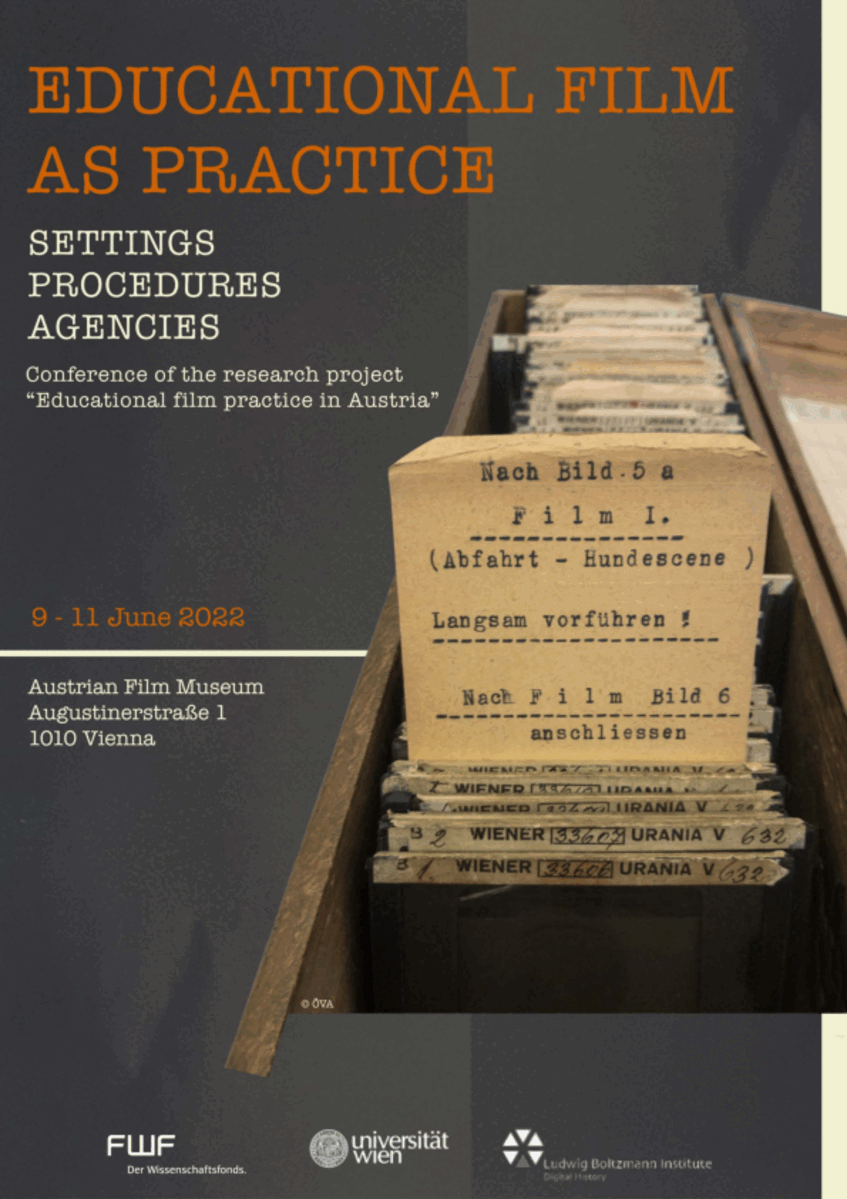
Impulse von gestern, haltbare Fragezeichen? Einsatz von Lehrfilmen im Deutschunterricht der Sekundarstufen 1 und 2
Fortbildung der Pädagogischen Hochschule Wien im Österreichischen Filmmuseum von Joachim Schätz und Marie-Noëlle Yazdanpanah.
Wie kann ich Lehrfilme in meinem Deutschunterricht einsetzen? Welche Quellen gibt es? Welche Lehrfunktionen können Filme und Videos wie erfüllen? Wie komme ich vom einzelnen z.B. Youtube-Video zu einer Unterrichtseinheit? Ausgehend von der historischen Perspektive und zahlreichen Beispielen aus der Geschichte und Gegenwart des Lehrfilmes stellen Joachim Schätz und Marie-Noëlle Yazdanpanah diese praktischen Fragen ins Zentrum der Veranstaltung. Dabei soll gemeinsam erprobt werden, ob bereits alle Möglichkeiten der Verwendung von Lehrfilmen Filmen und Videos im Unterricht ausgereizt sind oder noch ob – auch durch den Blick auf frühere filmpädagogische Ideen – kreatives Potential erschlossen werden kann. Es sind auch Lehrende anderer Fächer willkommen.
Ankündigung der PH Wien (pdf)
Quellenliste für die Fortbildung (pdf)
Ort: Österreichisches Filmmuseum, Augustinerstraße 1, 1010 Wien
Zeit: Montag, 07. März 2022, und Montag, 14. März 2022, je 14:00 bis 17:20
Veranstalter: Pädagogische Hochschule Wien
Bildcredit: Phoebe (1964, Regie: George Kaczender, National Film Board of Canada)
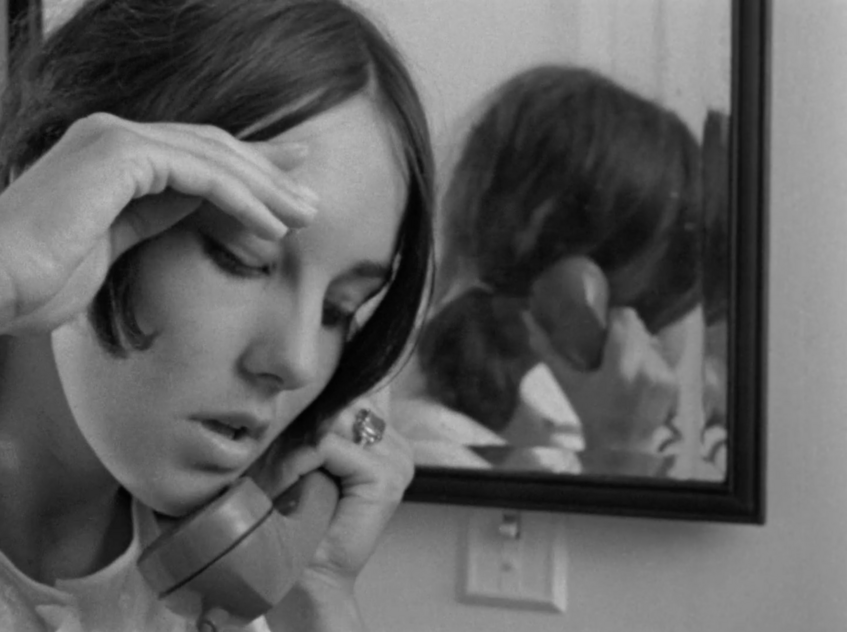
Filmische (Geschmacks-) Bildung und (staatspolitische) Erziehung durch Lehr- und Unterrichtsfilme im Austrofaschismus. Zum Projekt "Praktiken des Lehr- und Unterrichtsfilms in Österreich"
Vortrag von Katrin Pilz und Marie-Noëlle Yazdanpanah im Rahmen der "Interaktionen" des Instituts für Zeitgeschichte der Universität Wien.
Das Projekt Praktiken des Lehr- und Unterrichtsfilms in Österreich erforscht die Verwendung von Film in Erziehungs- und Lehrzusammenhängen in Österreich zwischen 1918 und etwa 1970 – im Klassenzimmer und im Rahmen der Volksbildung sowie im Kontext universitärer Lehre und Berufsbildung. Unser Verständnis von Praktiken umfasst neben den Filmen und den Institutionen, die diese in Auftrag gegeben und vertrieben haben, die Orte und Situationen der belehrenden und erziehenden Vorführung sowie die dazu erlassenen Rechtsvorschriften. Im Zusammenspiel von institutionellen Strategien, Vorführkontexten und den Inhalten und Stilen der gezeigten Filme nehmen diese Praktiken konkrete Formen an.Davon ausgehend nehmen wir die Zeit des Austrofaschismus in den Blick. Dabei fokussieren wir neue Forderungen und Maßnahmen wie die Etablierung einer systematischen Filmprüfung oder die Wiedereinführung der Filmzensur, die von bestehenden Institutionen und neugegründeten Vereinigungen vorangetrieben wurden. Wir diskutieren Vorstellungen und Vorschriften zum "richtigen" Einsatz des Lehrfilms, der als Teil eines Medienpakets (Vortrag, Lichtbilder, Karten usw.) neben der Vermittlung diverser Lehrinhalte filmische ("Geschmacks")-Bildung und (staatsbürgerliche) Erziehung leisten sollte, ebenso wie deren Umsetzung in Form individueller, regionaler Aktivitäten durch Lehrer:innen oder Volksbildner:innen. Dabei werden personelle und programmatische Kontinuitäten und Veränderungen sowohl zur Ersten Republik als auch zum Nationalsozialismus und der Zeit nach 1945 deutlich.
Programm (online)
Zugang via Zoom
Ort: Online via Zoom
Zeit: Donnerstag, 13. Jänner 2022, 12:00
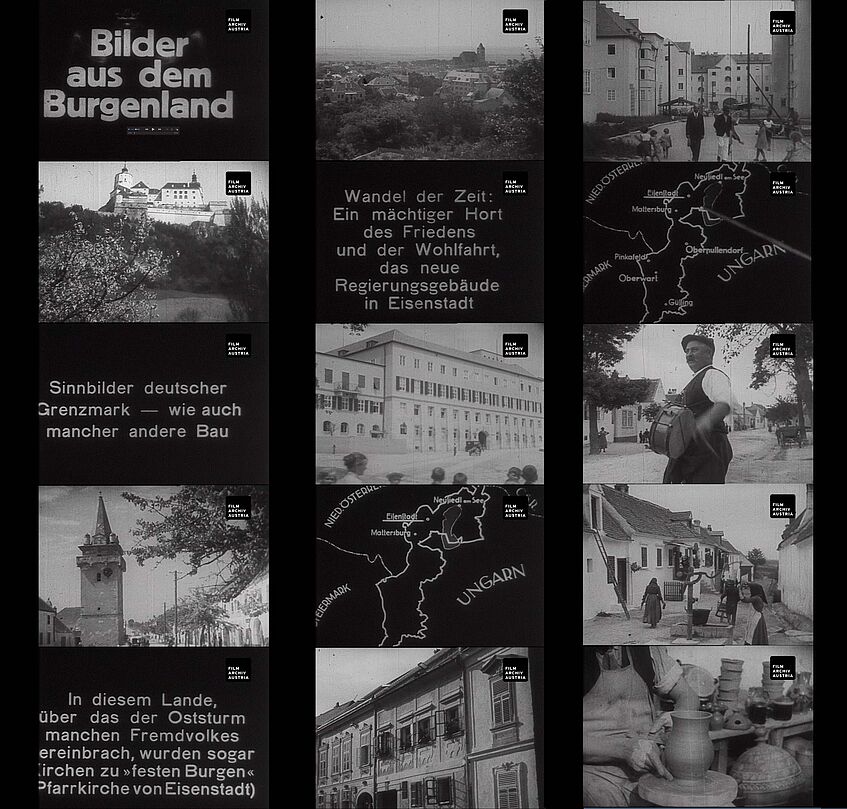
Filmic civics: Revisiting documentary’s pedagogical drive, 1924–1936
Panel des Projekts "Praktiken des Lehr- und Unterrichtsfilms in Österreich" auf der internationalen Tagung "Visible Evidence 2021: Documentary and Democracy in Crisis".
One of the tendencies currently discussed under the notion of a "crisis of democracy" is the increasing pressure that public and independent media have come under from right-wing governments as well as from a wide variety of pressure groups. This ranges from grievances eminently worthy of debate (for instance blind spots concerning gender identification or White bias) to conspiratorial ravings about "fake news" and the "lying press". Some television and video news media have reacted by doubling down on what is and isn’t fact – for instance via live-checking speech for factual errors. At this moment it bears remembering that when the mode of "documentary" emerged as a distinct way of mediatizing what’s going on in the world, the permeable border between recording facts and building opinions was not a bug, but precisely the point.
This is why we propose to go back to the period of documentary’s emergence and witness documentary’s pedagogical drive as it relates to democracies in crisis: Vrääth Öhner re-examines John Grierson’s definition of documentary film in comparison and contrast to educational film, starting off from a 1936 speech given at the National Union of Teachers’ Southport Conference. With a case study on a model classroom film from 1924/25 and its layered civics lessons Marie-Noëlle Yazdanpanah will then dive into educational film and its tenuous relation to the emerging documentary paradigm. The issue of democracy in crisis is forefronted in Joachim Schätz’s contribution on the Austrian Social Democrats’ use of non-fiction film while campaigning for the 1930 national election, the last one held in interwar Austria. Drawing on a cornerstone campaign film, a print of which was recovered in 2020, he identifies a pivot in their advertising toward the didactic power of "documents".
Respondent: Kay Hoffmann (Haus des Dokumentarfilms, Stuttgart)
PRESENTATIONS:
Vrääth Öhner: Grierson's Documentary Pedagogy
It is worth recalling that the British documentary group began not so much in affection for film per se as in affection for national education” (John Grierson, 1937). Nowhere does Grierson elaborate on this idea more precisely than in a lecture he gave at the 1936 Southport Conference of the National Union of Teachers on the subject of “Broadcasting and the Cinema as Instruments of Education”. While educational film, according to Grierson, plays only a supplementary role within the curriculum, documentary film responds to a fundamental crisis in the educational system that could easily develop into a fundamental crisis of liberal democracy.
The crisis is that formal education has lost touch with modern social life, that it continues to convey the old liberal, individualistic and rational theories that no longer do justice to the complexity and interconnectedness of the modern world. Documentary, however, is a response to this crisis in that it is able to really bring the outside world to life for the growing citizen.
Although Grierson repeats views that have already been extensively commented on, the modification he makes to the scheme of aesthetic education seems remarkable: The educational task of documentary consists less in mediating between sensuality and reason (as was envisaged by German cultural films, for example) than between particular private interests and scientific discourse. The scope and result of this modification will be the subject of my contribution, as well as the problems that documentary has to face as a consequence.
Marie-Noëlle Yazdanpanah: Life in a Burgenland Peasant Village – Territorial Claims and Identity Formation in Educational Films
An "uplift of national sentiment" and the presentation of a new territory unknown to Austrians were the declared goals of the educational film Life in a Burgenland Peasant Village (1924/25). Its precise and observational images present a seemingly never-changing circle of life, into which modernity has found its way through machines, but not concerning communal life. The Hungarian Burgenland was granted to Austria after World War I as late as 1921 and the only significant territorial gain of the new state. Burgenland was a highly contested space in a country whose sovereignty was permanently questioned in the interwar period, and the site of embittered conflicts about Austria’s democratic constitution, escalating in the famous Schattendorf killings of 1927.
In contemporary discourses, Burgenland was often imagined as a "foreign", backward "East"; at the same time, its "German" character was emphasized. The presentation examines how Life in a Burgenland Peasant Village can be located within these debates. How does it stage the "discovery" of the unknown and what ideas of national superiority guide its gaze? Produced on the initiative of teachers as a collaborative effort, this film is also a response to the lack of institutional support for educational film. How do the depiction of identity formation and confidence-building in an independent Austria differ in comparison with films commissioned by the state? And: What idea of civic education was conveyed cinematically, especially when another claim was to "plant respect for peasant labor into childrens' hearts" through aesthetically impressive images?
Joachim Schätz: Handheld Promises. Small-gauge didactics of political crisis in Austria ca. 1930
The 1930 national election campaign found Austria’s Social Democratic party at a precarious zenith: While membership was at a new height and efforts such as the Viennese housing program bore impressive fruit, attempts at social and economic reform had been stalled and right-wing political violence proliferated. The party answered this situation with a full-on multimedia campaign which was boosted by investment in new technologies, especially small-gauge film. For the first time, film use in the campaign was centrally managed by the Central Office for Workers’ Education, which also had campaign films be produced in-house. These films, as well as the concepts for film use promoted in the Central Office publication Bildungsarbeit perform a left-turn from the party’s use of film. They ditch newsreel objectivism and advertising gloss for a rhetoric that blends the epistemic value of the "document" with a stress on film’s "educational" efficacy.
In my presentation I argue that rather than merely playing catch-up with the alliances of left-wing politics with modernist film culture that were well-established at that time in Germany or the Netherlands, Austria’s Social Democrats put their own localized spin on this precarious relationship: Fritz Zvacek’s campaign film Schach der Wohnungsnot! (1930), of which a print was recovered in 2020, builds formal correspondences between handheld camera movements and Vienna’s non-modern commitment to brickwork, while film educators like Johann Fuchs or Hans Riemer developed concepts of film presentation that aimed to make filmic “records” speak within established party event structures.
Ort: Mousonturm, Waldschmidtstraße 4, 60316 Frankfurt am Main
Zeit: Donnerstag, 16. Dezember 2021, 12:00-13:30
Veranstalter: Goethe-Universität Frankfurt am Main
Bringing PR to the classroom: a short history of the Austrian Film Service
Vortrag von Joachim Schätz auf der internationalen Tagung "Energy Imaginaries: Public Relations and Moving Images".
Much of the history of educational film in Europe has been written as a history of purification according to pedagogical tenets. National institutions and teachers’ associations often defined their activities in contrast to the more utilitarian secondary exploitation of sponsored films in the classroom. Those films – often short documentaries with discreetly packaged messages concerning the commissioning company or political entity – were disparaged by high-ranking film pedagogues for disturbing both the pedagogical structure of the lesson and the supposed neutrality of formal education. In Switzerland, for instance, this tension between the proponents of sponsored education and its declared enemies structured the institutional history of educational film from the 1920s on. In Austria, sponsored education got its institutional champion somewhat later with the founding of Österreichisches Filmservice (Austrian Film Service) in 1969. This company served as an intermediary between schools (ranging from formal education to driving schools) and a range of domestic and international economic and political entities. For instance, these encompassed, in the 1969/70 catalogue, a whopping 32 (of 222) films from the South-African embassy, including films putting an inclusive spin on the country’s apartheid policy. In my presentation, I trace the development and swift rise of Austrian Film Service in the 1970s due to both competitively low cost to schools and a detailed feedback system for the clients. I argue that both their activities and the films they typically distributed can be profitably understood in the context of public relations and its belated professionalization in Austria. (The Austrian PR Society was founded in 1969, the same year as the Austrian Film Service.) The distinction from advertising that has remained crucial to public relations was consequential for the Austrian Film Service’s 1970s activities and portfolio in legal, logistical as well as poetological terms.
Ort: Filmhuset (The Film House), F-salen, Borgvägen 1, SE-115 53 Stockholm
Zeit: Donnerstag, 21. Oktober 2021, 11:00-12:30
Veranstalter: Stockholm University
Wissen für alle! Filme zur Volksbildung
Ein Filmprogramm im Rahmen der Veranstaltungsreihe Das Rote Wien_REVISITED, präsentiert und moderiert von Joachim Schätz.
Der Kinosaal war im 20. Jahrhundert nicht zuletzt ein Ort, an dem etwas über die Welt zu lernen war. Das gilt sogar für Betriebe wie das Sandleitenkino, das von seiner Eröffnung 1928 bis zu seiner Schließung 1966 vor allem gewinnorientiert auf Unterhaltung hin bespielt wurde. Das moderierte Filmprogramm geht entlang der Geschichte dieses Zeigeorts den lehrhaften Elementen in den Vorprogrammen der Wiener Kinos nach und wirft auch Seitenblicke auf die Filmarbeit von Volksbildungseinrichtungen.
Programm Das Rote Wien_REVISITED (pdf)
Ort: Soho Studios, Kunstlabor, Liebknechtgasse 32, 1160 Wien
Zeit: Freitag, 15. Oktober 2021, 19:00-21:00
Veranstalter: Soho Studios, in Kooperation mit Österreichisches Filmmuseum
Bildcredit: Dugi Otok (1959, Eric Egerer/Hermann Schacht, Quelle: Österreichisches Volkshochschularchiv)
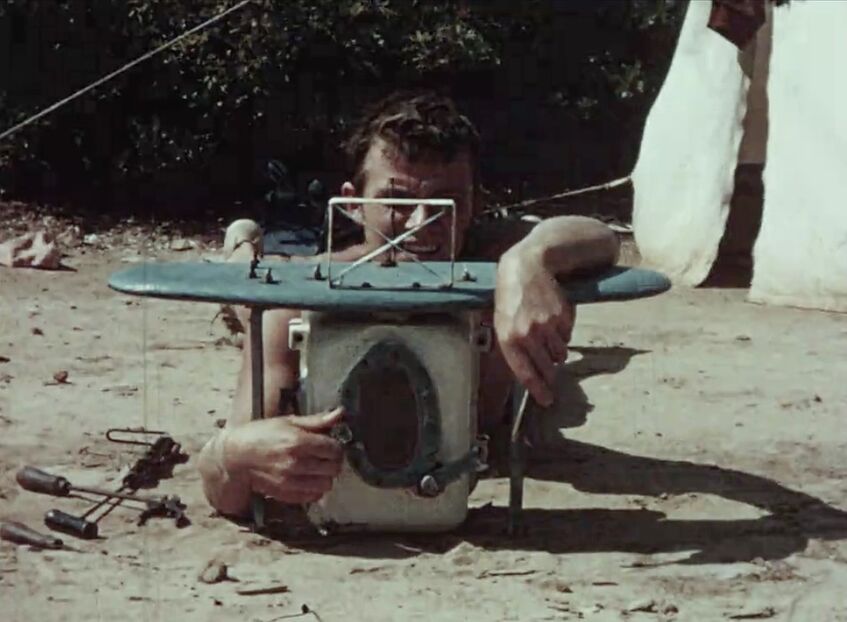
Workshop "Lehrfilmpraktiken"
Eine Veranstaltung des Forschungsprojekts "Praktiken des Lehr- und Unterrichtsfilms in Österreich".
Thema des zweitägigen Workshops sind Lehrfilmpraktiken: Gemeint sind damit einerseits die Anordnungen, Rahmungen und pädagogischen Prozesse, in denen Filme lehrhaft 'gemacht' wurden, andererseits die Weisen, auf die Filme pädagogische Praktiken ihrerseits geprägt und modifziert haben. Diskussionsgrundlage für die versammelten Expert_innen sind Präsentationen aus dem Projektteam und von drei internationalen Gästen (Kerrin von Engelhardt, Audrey Hostettler, Anja Sattelmacher), sowie andere Programmelemente: ein Filmprogramm und ein geführter Spaziergang an Orte der Lehrfilmpraktiken in der Umgebung des Tagungsorts.
Ort: Alois Wagner Saal, C3 – Centrum für internationale Entwicklung, Sensengasse 3, 1090 Wien
Zeit: Freitag, 17. September 2021, bis Samstag, 18. September 2021
Veranstalter: Universität Wien, Ludwig Boltzmann Institute for Digital History
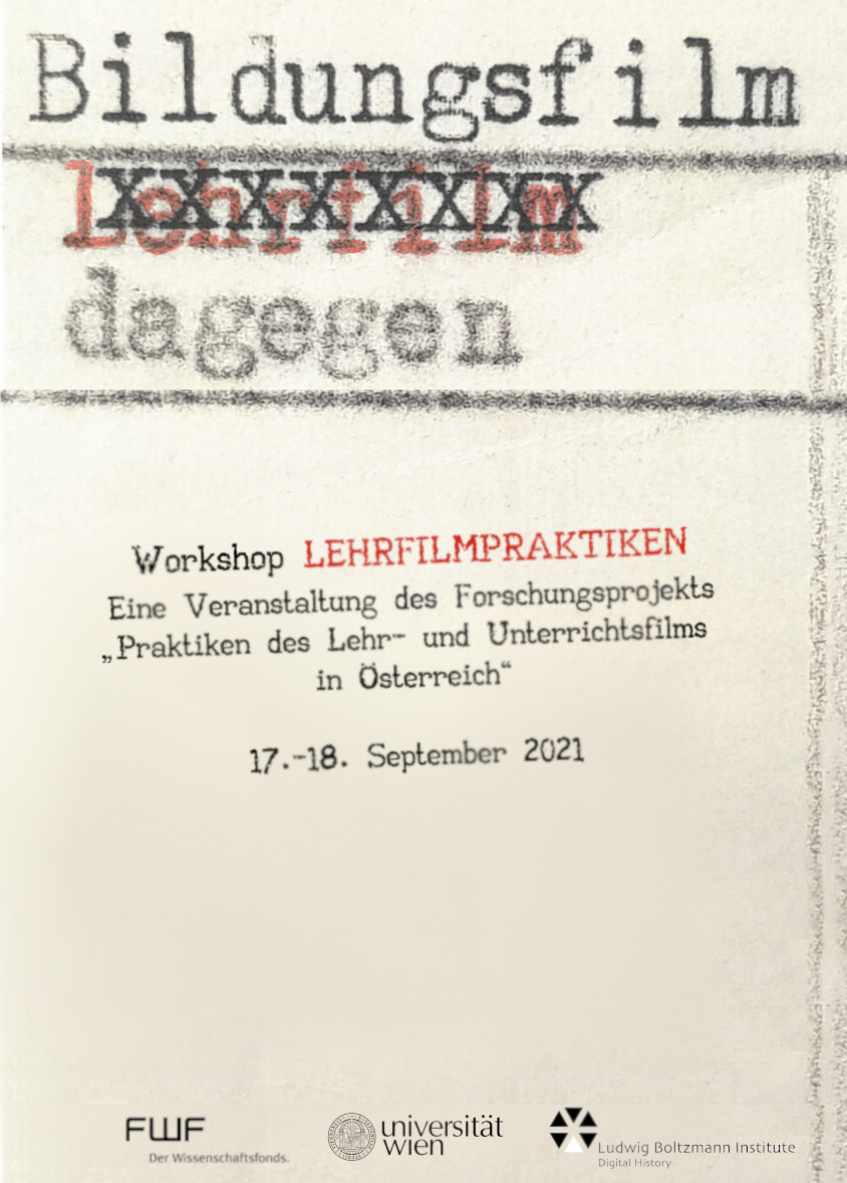
Praktiken des Lehr- und Unterrichtsfilms in Österreich – und was die (mündliche) Geschichte der lebenswissenschaftlichen Forschung und Lehre damit zu tun hat...
Werkstattgespräch von Katrin Pilz bei der internationalen Tagung "FoGeL 2021".
Vortrag sowie Podiumsdiskussion mit dem Themenschwerpunkt "Oral History in der Geschichte der Lebenswissenschaften" beim 7. Offenen Forum Geschichte der Lebenswissenschaften, veranstaltet im Vorfeld der GTG/GWMT-Jahrestagung in Kooperation mit dem Naturhistorischen Museum Wien und dem Institut für Geschichte der Universität Wien.
Ort: online
Zeit: Donnerstag, 16. September 2021, 14:50-16:00
Veranstalter: Institut für Geschichte der Universität Wien, Naturhistorische Museum Wien (NHM), Gesellschaft für Geschichte der Wissenschaften, der Medizin und der Technik (GTG/GWMT)
Invisible Diseases – Invisible Intertitles: comparative screening of two incunabular films in the fight against syphilis/STDs, 1919-1922
Filmeinführung und Podiumsdiskussion mit Katrin Pilz und Christian Bonah am Digital Symposium des World Knowledge Dialogue mit dem diesjährigen Thema "Neverending Infectious Diseases. Life Sciences, Life Cycles and Social-cultural Life 20th-21th Century".
Katrin Pilz stellt gemeinsam mit Christian Bonah von der Université de Strasbourg die Sexualaufklärungsfilme "Die Geschlechtskrankheiten und ihre Folgen (DEU 1919, AUT 1922)" vor und diskutiert diese mit weiteren PodiumsteilnehmerInnen im Kontext von "Prophylactic Wars (Guerre prophylactique)".
Ort: Digital Symposium, Triangle Azur consortium constituted by the Universities of Lausanne, Neuchâtel and Geneva
Zeit: Dienstag, 11. Mai 2021, 16:00-17:30
Veranstalter: Triangle Azur consortium constituted by the Universities of Lausanne, Neuchâtel and Geneva in cooperation with MedFilm, Université de Strasbourg
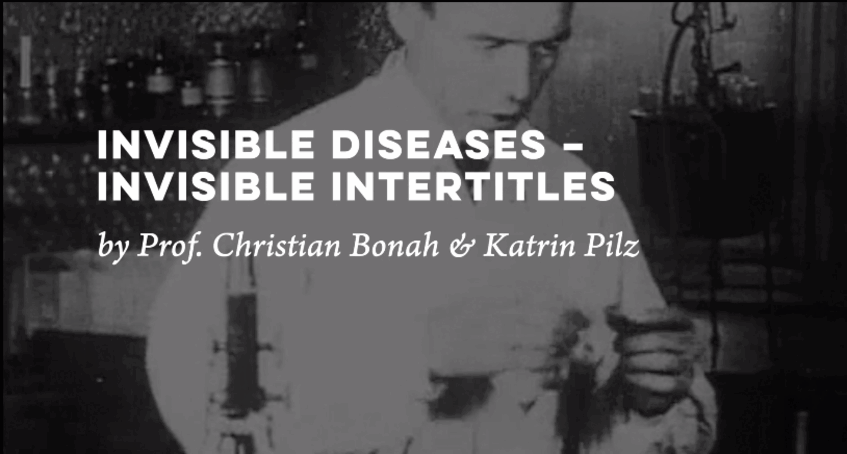
The water flea – a microcinematographic iconic object entering the national and transnational classroom
Vortrag von Katrin Pilz auf der internationalen Tagung "Sound and Vision: exploring the role of audio and visual technologies in the history of education"
Der Vortrag diskutiert historische mikrokinematographische Aufnahmen, die sowohl in der wissenschaftlichen Wissensvermittlung als auch im Schullehrunterricht zirkulierten. In diesem Kontext werden nationale und internationale Debatten zur Standardisierung von „use of the film for teaching purposes“ betrachtet und erörtert was der Wasserfloh mit all dem zu tun hatte.
Ort: Bengoo & B-Magic Online Conference (Microsoft Teams)
Zeit: Donnerstag, 22. April 2021, 14:30-15:00
Website (link) https://ppw.kuleuven.be/ecs/aanbod/sound-and-vision-final-program.pdf
Veranstalter: KU Leuven
DIY versus Ditmar 1006: The institutional politics, national economics and media ecology of classroom projectors made in 1950s Austria
Vortrag von Joachim Schätz auf der internationalen Tagung "Sound and Vision: exploring the role of audio and visual technologies in the history of education"
Der Vortrag rekonstruiert die Produktion von Schulfilmprojektoren durch österreichische Firmen in den 1950er Jahren, die wesentlich von der Bundesstaatlichen Hauptstelle für Lichtbild und Bildungsfilm angeleitet und beraten wurde. Diese Abteilung des Unterrichtsministeriums bestimmte durch die Konstruktionsform der Geräte bewusst die Gebrauchsweisen von Film im Klassenzimmer mit und stellte visuelle Lehrmedien zur Unterweisung im Gebrauch der Projektoren her.
Ort: Bengoo & B-Magic Online Conference (Microsoft Teams)
Zeit: Donnerstag, 22. April 2021, 14:00-14:30
Website (link) https://ppw.kuleuven.be/ecs/aanbod/sound-and-vision-final-program.pdf
Veranstalter: KU Leuven
Ringvorlesung "Highlights der Lehrfilmanalyse. Audiovisuelle Argumentationen und Wissenskommunikation"
Eine Ringvorlesung an der Humboldt-Universität zu Berlin, geleitet von Julia B. Köhne und Katrin Pilz.
Wie inszenieren Wissenschaftsfilme wissenschaftliches Wissen und Forschungsbewegungen? Welche Bilder von Wissenschaft und (‚guter‘, moderner und reflektierter) Wissenschaftlichkeit transportieren sie? Welche Funktionen übernehmen verfilmte Bilder in der Wissenschaft und für dieselbe, und darüber hinaus?
Die internationale Ringvorlesung präsentiert interdisziplinär orientierte Wissenschaftler/innen aus Kulturwissenschaft, Geschichtswissenschaft, Wissenschaftsgeschichte/Epistemologie, Bildungsforschung, Medizingeschichte, Film- und Medienwissenschaft und den Visual Arts, die ausgewählte Wissenschaftsfilme in Verbindung mit den entsprechenden Medientechnologien aus dem transnationalen Raum genreübergreifend analysieren. Das Spektrum reicht von der frühen Kinematographie, dem „cinema of attractions“ (T. Gunning), Medizinfilmen aus der Anatomie und Neuropsychiatrie und populärwissenschaftlichen Filmen zur Gesundheitsprophylaxe und Krankheitsprävention, über Mikro/Makro- und Röntgenkinematographie zur Fixierung des zuvor (ohne Filmkamera in Kombination mit medizinischen Visualisierungstechnologien) Unsichtbaren bis hin zu verfilmten Experimentalanordnungen oder chirurgischen Operationen. Zudem werden Filme der Humanethologie und menschlichen und tierlichen Verhaltensforschung sowie Reise- und Expeditionsfilme, inklusive Recyclingpraktiken von pädagogischem Filmmaterial, thematisiert. Die Vorlesung blickt auf Werbe- und Propagandafilme für wissenschaftliche Leistungen und Public Health-Einrichtungen (z.B. Antialkoholinitiativen, Belehrungen über Epidemien, Tropenerkrankungen, Sexualaufklärung, -hygiene und -politik, Sozialreformen) sowie auf schulische Lehrfilme der DDR und Zeichentrickfilme der Walt Disney Company (u.a. Tierfilme, Atomenergieforschung).
Mit Vorträgen von Katrin Pilz und Joachim Schätz aus dem Projektteam "Praktiken des Lehr- und Unterrichtsfilms in Österreich".
Ort: online
Zeit: Donnerstag, 22. April 2021, bis Donnerstag, 15. Juli 2021
Veranstalter: Humboldt-Universität zu Berlin
Zwecke & Zwillinge. Was die Filmwissenschaft aus Lehr- und Wissenschaftsfilmen lernt
Vortrag von Joachim Schätz im Rahmen der Ringvorlesung "Methoden der Theater-, Film- und Medienwissenschaft"
Ort: Online (öffentliches Zoom-Meeting)
Zeit: Dienstag, 3. November 2020, 11:30-13:00
Veranstalter: tfm | Institut für Theater-, Film- und Medienwissenschaft, Universität Wien
Rudolf Enter, Film-Animateur
Online-Filmprogramm, zusammengestellt und eingeführt von Vrääth Öhner, im Rahmen des Home Movie Day 2020
Rudolf Enter, Jahrgang 1927, hat seine Leidenschaft für den Trickfilm nach eigenem Bekunden bereits in der Kindheit entdeckt: Mit 10 oder 12 Jahren begann er, auf blanken Zelluloidstreifen mit Tusche und Feder erste Bewegungsphasen zu zeichnen. Ende der 1960er Jahre drehte er seine ersten Farb-Zeichenfilme, wenig später dann auch Puppentrickfilme für den Schulgebrauch im Auftrag des Österreichischen Bundesministeriums für Unterricht. Wie die kleine Auswahl aus seinem umfangreichen Werk zeigt, hat Rudolf Enter aber nicht nur Filme animiert, sondern auch Menschen zum Filmen.
Filme von Rudolf Enter:
Zu Besuch bei der Filmfachgruppe – ca. 1950, 9,5mm, sw, stumm, 8 min
Die Sterntaler – 1986, Super 8, Farbe, Magnetton, 10 min
Puppentrickfilme - aus der Praxis für die Praxis – 1986, Super 8, Farbe, Magnetton, 13 min
Mit einer Einführung von Vrääth Öhner (Ludwig Boltzmann Institute for Digital History) im Rahmen des FWF Forschungsprojekts "Praktiken des Lehr- und Unterrichtsfilms in Österreich"
Zeitraum: Samstag, 17. Oktober 2020, 16:00, bis Samstag, 31.10.2020, 22:00
Veranstalter: Österreichisches Filmmuseum, Center for Home Movies
Formen folgen Funktionen. Forschen zu Gebrauchsfilmen
Vortrag von Joachim Schätz im Rahmen der Ringvorlesung "Methoden der Theater-, Film- und Medienwissenschaft"
Ort: Institut für Theater-, Film- und Medienwissenschaft, UZA II/Geo-Zentrum, Hörsaal 3, Althanstr. 14, 1090 Wien
Zeit: Dienstag, 10. Dezember 2019, 11:30-13:00
Veranstalter: tfm | Institut für Theater-, Film- und Medienwissenschaft, Universität Wien
Animierte Wissenschaft: Die Filmkamera als populäres und umstrittenes Lehr- und Forschungsinstrument in der Medizin
Vortrag von Katrin Pilz auf der internationalen Konferenz „Medical Humanities – Interactions between Medicine and the Arts“
Ort: Hörsaalzentrum, Medizinische Universität Wien, Währinger Gürtel 18-20, 1090 Wien
Zeit: Samstag, 12. Oktober 2019, 08:30
Veranstalter: Arbeitsgruppe Geschichte der Medizin der Österreichischen Akademie der Wissenschaften und der Medizinischen Universität Wien
Praktiken des Lehr- und Unterrichtsfilms in Österreich. 3x Methoden nach 3 Monaten
Vortrag von Katrin Pilz und Joachim Schätz beim 16. Forschungstag am tfm | Institut für Theater-, Film- und Medienwissenschaft der Universität Wien
Ort: Institut für Theater-, Film- und Medienwissenschaft, UZA II/Rotunde, Raum 2H558, Althanstr. 14, 1090 Wien
Zeit: Mittwoch, 2. Oktober 2019, 13:10-13:50
Veranstalter: tfm | Institut für Theater-, Film- und Medienwissenschaft, Universität Wien
„Aus gleichen Teilen Talg und Terpentinöl“. Lehrfilm als Beziehungsarbeit mit Dingen
Vortrag von Joachim Schätz bei der Jahrestagung der Gesellschaft für Medienwissenschaft zu „Medien-Materialitäten“ (Panel: „Schmiermittel des Films. Funktionalität und Widerspenstigkeit“)
Ort: Universität zu Köln, Philosophikum, Seminarraum S 85, Universitätsstraße 41, 50931 Köln, Deutschland
Zeit: Samstag, 28. September 2019, 13:00-15:00
Die Anschaulichkeit, die seit Anfang des 20. Jahrhunderts als Argument für Film als Lehrmittel ins Treffen geführt wird, meint nicht zuletzt eine Anschaulichkeit von Dingen. Lehren mit Film folgt seit den „Mustervorstellungen“ des Kinoreformers Hermann Häfker in den 1910er Jahren häufig dem Paradigma des Anschauungsunterrichts, auf Englisch geläufig als ‚the object lesson‘. Einzelne Objekte – ob keimende Pflanze, laufende Maschine oder zu bindende Krawatte – werden aus einem größeren Zusammenhang gelöst, in pädagogisch dosierter Detailgenauigkeit und Geschwindigkeit zu sehen gegeben und erläutert.
‚Object lessons‘, Lektionen in der medienästhetischen Bearbeitung und Prozessierung von Objekten, erteilen Lehrfilme auch denen, die sie herstellen und zeigen. In der Fachpublizistik des Lehrfilms zerfällt die unterstellte Affinität des Films zum bewegten Objekt in eine kleinteilige Beziehungsarbeit an und mit Dingen. Deren Sicht- und Lesbarkeit wird nicht erst dort zum Problem, wo Mikrofotografie und Zeitraffer benötigt werden, sondern etwa bereits bei den störenden Lichtreflexen glänzender Maschinenflächen, denen mit Schmiere (Rezeptur: siehe Titel) abgeholfen werden soll.
Auch die Vorführung gestalten Dinge und ihre (nicht immer souveräne) Handhabe entscheidend mit, von Rohrstab und Filmbroschüren bis zu Projektoren mit eigenem Kühlsystem, die in den 1920er Jahren den gefahrlosen Bildstopp an Nitrofilmen ermöglichen sollen. Diese Dingverhältnisse des Lehrfilms bringen unterschiedliche Konzepte von Materialität ins Spiel, womöglich in Beziehung: die materiellen Effekte und Verkettungen von Dispositiven (unterschiedlich nach Foucault und Baudry/Kessler) und Gefügen mit einer Materialästhetik des Films, die im Intimkontakt mit Texturen und Bewegungen mitunter ins Blitzen und Schwirren gerät.
Veranstalter: Institut für Medienkultur und Theater, Universität zu Köln
New Health Educators: Film as Public Educational Tool Challenging Concepts of Health and Disease (Medical Film Collections in Austria)
Vortrag von Katrin Pilz
Ort: Descartes Centre for the History and Philosophy of the Sciences & the Humanities Department of Utrecht University, Adresse: 3512 BS Utrecht, Niederlande
Zeit: Samstag, 27. Juli 2019, 09:00
History of Science Society, Annual Conference Utrecht 2019: Telling the Stories of Science
Panel: Science on the Film Strip: Collecting, Preserving and Archiving Research and Educational Films
Medical research-, educational-, and public health films have recently been rediscovered by archives and scholars in different fields. The institutional turn to the proper production and distribution of medical films in Austria starts with the founding of the Staatliche Filmhauptstelle in Vienna in 1919 as well as activities of the Uraniafilm department from 1922 on, the Schulkinobund in 1925 and international educational film associations debating on the psychological and didactical value and uses of hygiene, sex education and disease/accident prevention films and their impact on respective target groups in a more structured way. The implementation of film in higher and public education after WWI and the visualisation of scientific and physiological phenomena now visible through mechanically reproduced motion pictures, such as X-ray films, microcinematography or invasive surgical and obstetric training films, helped to promote but also challenged complex fields such as medicine and public health. The delay in and relative sparseness research on medical educational films have a variety of archival and conceptual reasons. Many collections of medical (educational) films in Austria and elsewhere, after their use value expired, were forgotten, disposed of or stored away in hospital vaults without proper archival care. Their separation from accompanying materials (production notes, research reports, teachers’ guides, booklets) further hindered the evaluation and appreciation of these collections’ significance.
Veranstalter: History of Science Society (HSS), Descartes Centre for the History and Philosophy of the Sciences & the Humanities Department of Utrecht University
